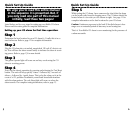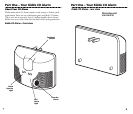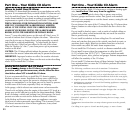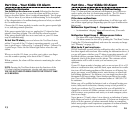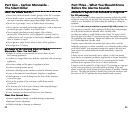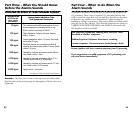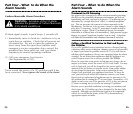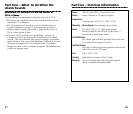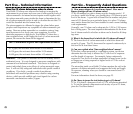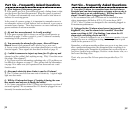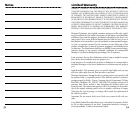
3029
Part Six – Frequently Asked Questions
Q. How many alarms do I need in my house? How much
square footage will one CO alarm cover?
A. We recommend you place alarms near the sleeping area(s). If
you have a multi-level home, you should place a CO alarm on each
level of the home. A good rule of thumb for the number and place-
ment of CO alarms for your particular home is to place CO alarms
near smoke alarms that have been installed to meet current building
code requirements.
Generally, one CO alarm can be adequate for 1,200 to 1,500 square
feet of living space. The most important determination for the num-
ber of alarms needed is whether an alarm can be heard in all sleep-
ing areas.
Q. What is the lowest level at which the CO alarm will sound?
A. The lowest level of carbon monoxide at which the alarm will
sound is 45 ppm. The CO alarm must be exposed continuously to
this level for at least three hours.
Q. Can you explain what “time-weighted alarm” means?
A. Because carbon monoxide is a cumulative poison, two factors
determine how the body is affected by CO: the level of exposure
and the length of exposure. For example, being continuously
exposed to low levels of carbon monoxide for many hours can be
as dangerous as being exposed to higher levels of CO for a short
period of time.
The microchip inside your Kidde CO alarm monitors the air for the
presence of carbon monoxide and computes the levels and length
of exposure, alarming when you should be concerned about CO
exposure.
For more information about the alarm, see page 29.
Q. Do I have to press the test button to get a CO alarm?
A. No. If it detects a dangerous level of CO it will alarm automatical-
ly. To test the internal components and circuitry of your CO alarm,
press the Test/Reset button.
Part Five – Technical Information
How the CO alarm determines when to alarm
Your Kidde CO alarm uses advanced technology to monitor the
environment in your home and warn you of unacceptable levels of
carbon monoxide. An internal microcomputer works together with
the carbon monoxide sensor inside the alarm to determine the lev-
els of carbon monoxide in the air and to calculate the rate that CO
would be absorbed into the human body.
The microcomputer is calibrated to trigger the alarm before most
people would experience any symptoms of carbon monoxide poi-
soning. Because carbon monoxide is a cumulative poison, long-
term exposures to low levels can cause symptoms, as well as
short-term exposures to high levels. Your Kidde CO alarm has a
time weighted alarm, so the higher the level of carbon monoxide
present, the sooner the alarm will be triggered.
This CO alarm meets response time requirements as follows:
At 70 ppm, the unit must alarm within 60-240 minutes.
At 150 ppm, the unit must alarm within 10-50 minutes.
At 400 ppm, the unit must alarm within 4-15 minutes.
WARNING: This product is intended for use in ordinary indoor
residentual areas. It is not designed to measure compliance with
commercial and industrial standards. This device is designed to
protect individuals from acute effects of carbon monoxide expo-
sure. It will not fully safeguard individuals with specific medical
conditions. If in doubt, consult a medical practitioner.
Individuals with medical problems may consider using warning
devices, which provide audible and visual signals for carbon
monoxide concentrations under 30 ppm.



